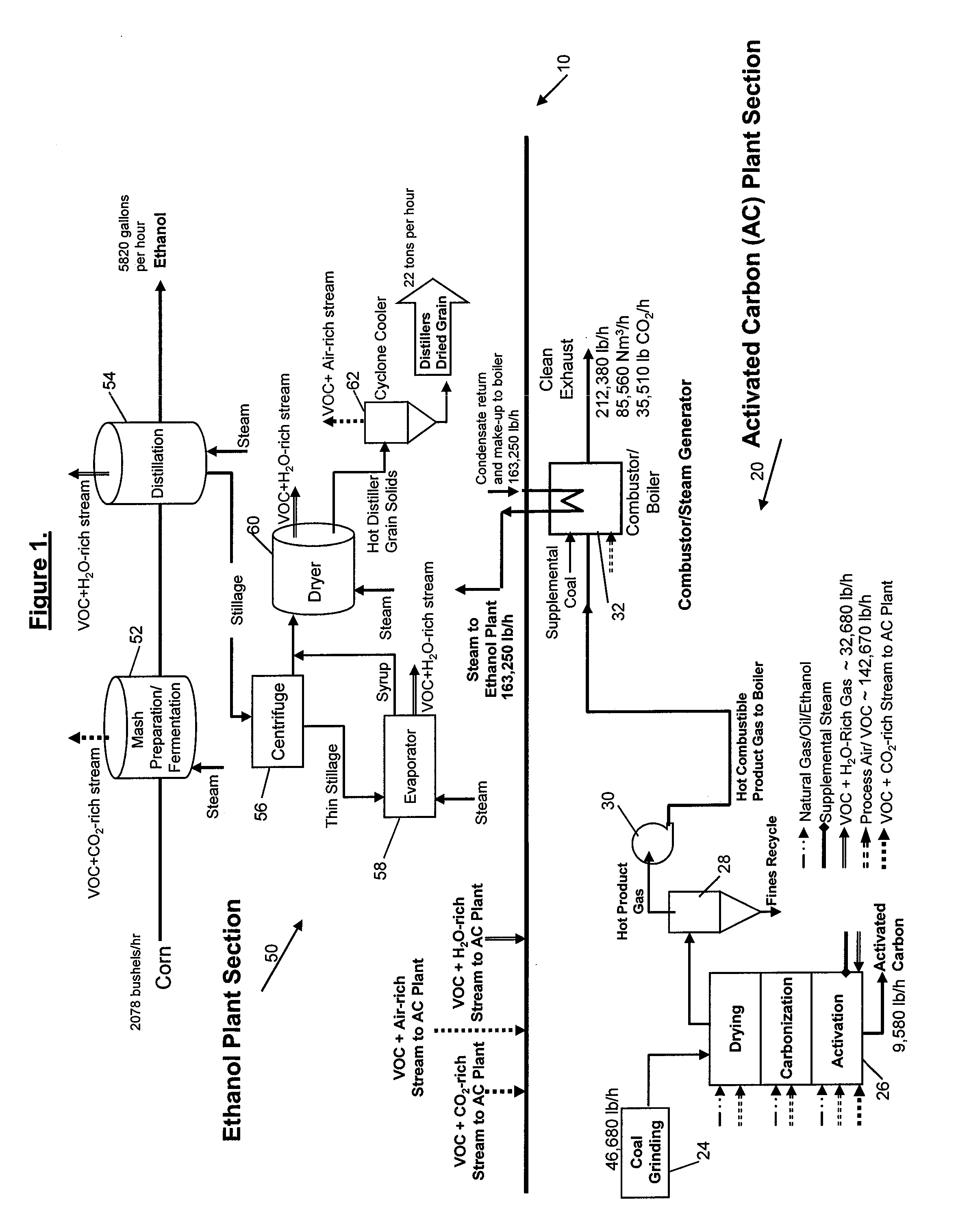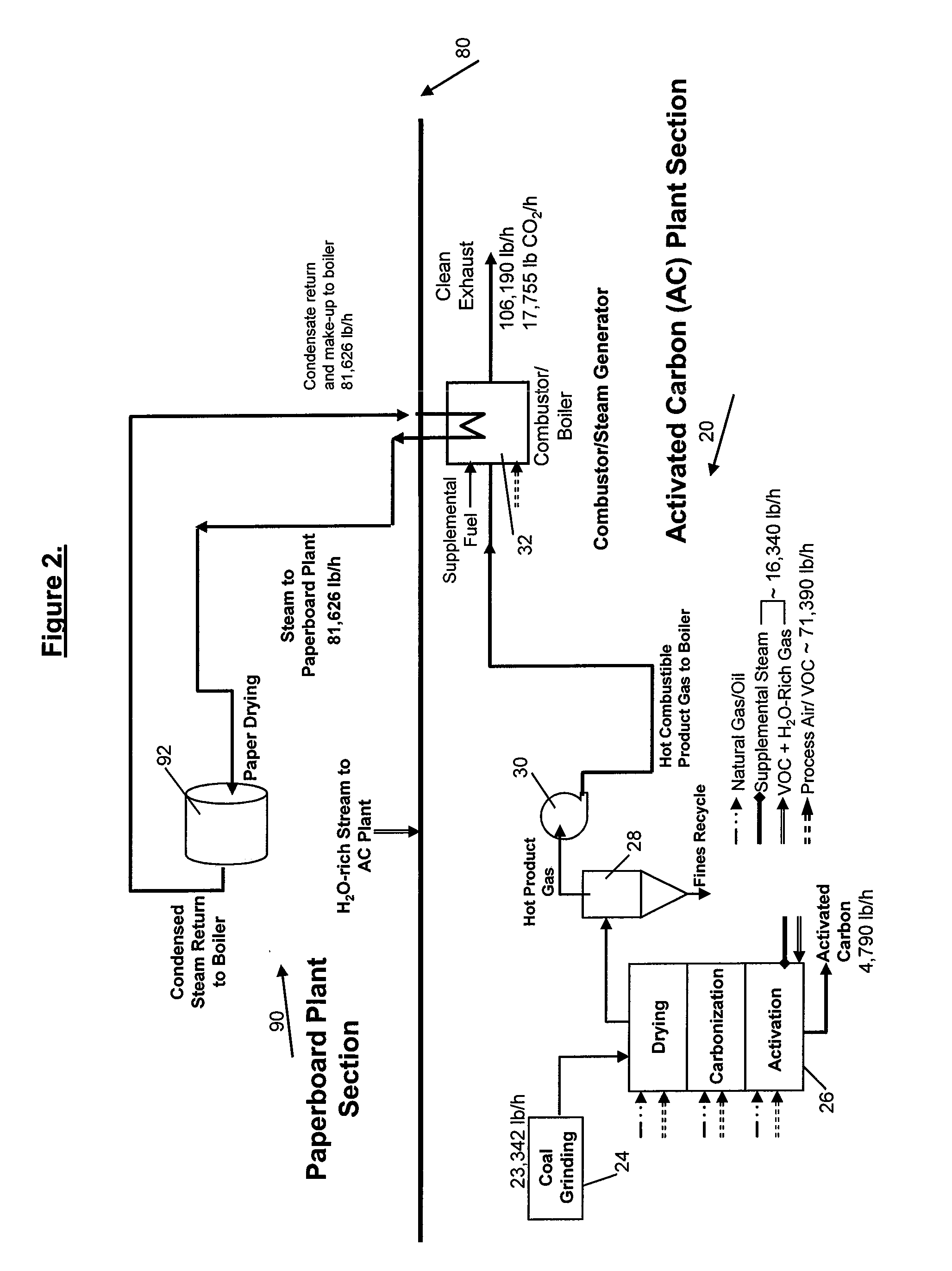Method of Manufacturing Carbon-Rich Product and Co-Products
a technology of carbon-rich products and co-products, applied in the direction of steam engine plants, steam machines/engines, steam engine use, etc., can solve the problems of low operating cost, inefficiency, and equipment that is more expensive than, and achieve the effect of simple and cost-effectiv
- Summary
- Abstract
- Description
- Claims
- Application Information
AI Technical Summary
Benefits of technology
Problems solved by technology
Method used
Image
Examples
example 1
Ethanol and Activated Carbon Production Plant
[0095]An ethanol and activated carbon production plant with the identified improvements (FIG. 1) and advantages relative to stand-alone plants is described below. Coal (lignite) of the composition provided below is used as feed stock.
Compositionwt-%CCarbon34.6HHydrogen3.5SSulfur0.61OOxygen21.6NNitrogen0.66Ash7.0H2OMoisture32.0
[0096]Activated carbon yield from the activated carbon production reactor is about 20-30 percent based on wet feed input. For a 46,684 lb / hour wet lignite input, this plant yields about 9,580 lb / hour (20% yield) of activated carbon product.
[0097]A typical activated carbon composition is shown below obtained from processing the above-described feed stock in the proposed inventive method.
Compositionwt-%CCarbon68HHydrogen0.5SSulfur1.5OOxygen0.5NNitrogen0.7Ash28.0H2OMoisture1.0
[0098]Steam requirement for activation for the activated carbon production plant is about 0.7 lb of steam per pound of wet feed. For a 46,684 lb / h...
example 3
Coal-Fired Activated Carbon Plant with Flue Gas Quench
[0108]An example of a typical coal-fired activated carbon production plant is provided below. Lignite of the composition provided in the previous example is used as feed stock. Activated carbon yield is about 20 percent based on wet feed input. A portion of the heat generated from the combustion of the product gases from the reactor is used to generate process steam. Steam requirement for the activated carbon production plant is about 0.7 lb of steam per pound of wet feed. For a 46,684 lb / hour wet lignite input, this translates to about 32,680 lb / hour of steam. This plant yields about 9,580 lb / hour of activated carbon product. The remainder of the heat from the combustion of the product gas from the activated carbon production reactor has to be quenched with a water spray. About 133,380 lb / hour of water is required to quench the flue gases and achieve an outlet flue gas temperature of about 300° F., which is optimum for operation...
example 4
Coal-Fired Activated Carbon Plant with Heat Recovery for Power Generation
[0109]In a typical coal-fired activated carbon production plant flow diagram with heat recovery for power generation, lignite of the composition provided in the previous examples is used as feed stock. Activated carbon yield is about 20 percent based on wet feed input. A portion of the heat generated from the combustion of the product gases from the reactor is used to generate process steam. Steam requirement for the activated carbon production plant is about 0.7 lb of steam per pound of wet feed. For a 46,684 lb / hour wet lignite input, this translates to about 32,680 lb / hour of steam. This plant yields about 9,580 lb / hour of activated carbon product. The remainder of the heat from the combustion of the product gas from the activated carbon production reactor is cooled, while additional steam is generated. This steam is sent to a steam turbine for electricity production. About 10 MWe of electricity can be expec...
PUM
| Property | Measurement | Unit |
|---|---|---|
| surface area | aaaaa | aaaaa |
| surface area | aaaaa | aaaaa |
| temperatures | aaaaa | aaaaa |
Abstract
Description
Claims
Application Information
 Login to View More
Login to View More - R&D
- Intellectual Property
- Life Sciences
- Materials
- Tech Scout
- Unparalleled Data Quality
- Higher Quality Content
- 60% Fewer Hallucinations
Browse by: Latest US Patents, China's latest patents, Technical Efficacy Thesaurus, Application Domain, Technology Topic, Popular Technical Reports.
© 2025 PatSnap. All rights reserved.Legal|Privacy policy|Modern Slavery Act Transparency Statement|Sitemap|About US| Contact US: help@patsnap.com



